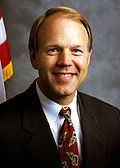| 104th United States Congress | |
|---|---|
103rd ← → 105th | |
 United States Capitol (1996) | |
January 3, 1995 – January 3, 1997 | |
| Members | 100 senators 435 representatives 5 non-voting delegates |
| Senate majority | Republican |
| Senate President | Al Gore (D) |
| House majority | Republican |
| House Speaker | Newt Gingrich (R) |
| Sessions | |
| 1st: January 4, 1995 – January 3, 1996 2nd: January 3, 1996 – October 4, 1996 | |
The 104th United States Congress was a meeting of the legislative branch of the United States federal government, composed of the United States Senate and the United States House of Representatives. It met in Washington, D.C. from January 3, 1995, to January 3, 1997, during the third and fourth years of Bill Clinton's presidency. Apportionment of seats in the House of Representatives was based on the 1990 United States census.
Contents
- Major events
- Major legislation
- Party summary
- Senate
- House of Representatives
- Leadership
- Senate 2
- House of Representatives 2
- Caucuses
- Members
- Senate 3
- House of Representatives 3
- Changes in membership
- Senate 4
- House of Representatives 4
- Committees
- Senate 5
- House of Representatives 5
- Joint committees
- Employees
- Legislative branch agency directors
- Senate 6
- House of Representatives 6
- See also
- Notes
- References
- External links
Both chambers had Republican majorities for the first time since the 83rd Congress in 1953. Major events included passage of elements of the Contract with America and a budget impasse between Congress and the Clinton administration that resulted in the federal government shutdown of 1995 and 1996.















